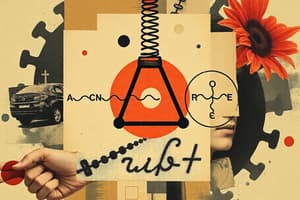Podcast
Questions and Answers
What are coupled reactions?
What are coupled reactions?
Where a spontaneous exergonic reaction is used to drive a non-spontaneous endergonic reaction by coupling together.
Give an example of a coupled reaction.
Give an example of a coupled reaction.
The coupling of the exergonic hydrolysis of ATP with the endergonic reaction of glucose to lactic acid.
Change in G is the maximum ______ that can be obtained from a chemical reaction.
Change in G is the maximum ______ that can be obtained from a chemical reaction.
work
Change in G is the driving force for ______.
Change in G is the driving force for ______.
If Change in G is zero, the system is at equilibrium.
If Change in G is zero, the system is at equilibrium.
What are the equations for Change in G?
What are the equations for Change in G?
Flashcards are hidden until you start studying
Study Notes
Coupled Reactions
- Coupled reactions combine a spontaneous exergonic reaction with a non-spontaneous endergonic reaction, enabling the latter to proceed through energy transfer.
Example of a Coupled Reaction
- The hydrolysis of ATP, an exergonic process, can be coupled with the endergonic reaction of glucose converting into lactic acid, maintaining a negative change in Gibbs free energy (ΔG).
ΔG and Work
- ΔG represents the maximum amount of work obtainable from a chemical reaction, providing insights into the efficiency and spontaneity of the reaction.
ΔG as Driving Force
- Change in Gibbs free energy (ΔG) serves as the driving force behind both physical and chemical transformations, indicating whether a process can occur spontaneously.
Equilibrium Condition
- When ΔG equals zero, the system is in a state of equilibrium, meaning there is no net change occurring in the concentration of reactants and products.
Equations for ΔG
- Two key formulas for calculating ΔG include:
- ΔG = ΔG° + RT ln Q
- ΔG = -RT ln K
- These equations relate standard Gibbs free energy change to reaction quotients (Q) and equilibrium constants (K).
Studying That Suits You
Use AI to generate personalized quizzes and flashcards to suit your learning preferences.



